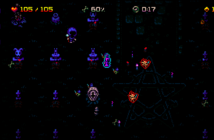
The specific origin of Thrash is arguable, but many say that it was heavily influenced, if not created, by the metal band Venom in the late 1970’s. However, it did not evolve into an entire genre until the early 1980’s with the appearance of Metallica on the scene. They took the heavy sound of the NWOBHM and made it even heavier, with more distorted guitars and heavy, pounding drum beats. The vocals were commonly much less focused on the soaring vocals of bands like Judas Priest, and more on a gruff, angry delivery, seeming almost like shouting at times.
Metallica released the album “Kill ‘Em All” in 1983, and though it was a rough, unpolished album, it led the way for many more bands in the next few years. The next Thrash presence to appear was Slayer, who formed in the same year as Metallica. They released their debut album six months after Metallica released theirs. Slayer quickly gained recognition for their talented guitarist Jeff Hanneman.
As Thrash became more popular, the other two members of the “Big Four,” the most prominent Thrash bands, appeared. Anthrax released their debut in 1984, which featured vocals of a much higher pitch than that of the other three bands. In contrast, Megadeth was founded by former Metallica guitarist Dave Mustaine in 1985, and they featured a much more gruff, grungy style, more similar to Metallica.
Thrash lead to a new boom in the popularity of Heavy Metal, with each of the Big Four bands gaining quite a bit of recognition in the industry. While the genre was in its hayday, however, another prominent metal genre was born: Death Metal. This genre was much less accessible due to its deep, heavily distorted sound and growled vocals rather than sung ones.
Death Metal was created by the bands Possessed and Death, and featured much more rhythmically complex and technically structured instrumentals than Thrash. While Thrash featured more gruff vocals, Death Metal went even further in their alteration of traditional vocal styles. Instead of singing, their vocalists were known for guttural, animalistic growls as they delivered their lyrics. The lyrics themselves were incredibly diverse, ranging from horror themes and violence to philosophical theories and political criticism. The genre went on to evolve into its two primary forms: Technical Death Metal and Melodic Death Metal.
Technical Death Metal featured very structured, very technical instrumentals focused around a more advanced, complex musical structure than pure Death Metal. This style was pioneered by Death in their later years, along with the bands Pestilence and Atheist.
In contrast to Technical Death Metal, Melodic Death Metal was a callback to the days of the NWOBHM. Melodic Death Metal bands combined the smooth, rhythmic guitar riffing of the older British bands with the harsh vocal and instrumental styling of traditional Death Metal. Melodic Death Metal was originated in Sweden and the U.K. by the bands At The Gates, In Flames, Dark Tranquility, and Carcass.
Both of the sub genres of Death Metal are still incredibly prevalent in the metal scene, specifically in European bands. Scandinavia, Sweden specifically, has an enormous Death Metal scene, and is the home of some of the best bands in the genre.
In the early 1990’s, another genre of metal evolved out of a combination of Funk, Rap, and earlier Heavy Metal. This new genre was labeled Nu-Metal, and it was pioneered by the Californian band Korn. Korn took the distorted guitar and heavy drumming of metal and combined it with the rhythmic beats and poetic lyrical structure of Rap. This new style was more accessible to fans of other genres of music, and lead to another boom in the popularity of Heavy Metal. Along with Korn, other bands such as Limp Bizkit, Slipknot, and Deftones were also instrumental in the creation of the genre.
By the late 1990’s Nu-Metal had gained a massive amount of popularity. Slipknot had a massive following due to their incredibly aggressive lyrics, loud and complex instrumentals, and impressive live performances by the nine members of the band. Limp Bizkit was stylistically closer to Rap than the other pioneering bands of the genre, focusing less on the instrumentals and more on vocalist Fred Durst’s rapping. Deftones had a more technical style, with more complex structuring than many other Nu-Metal bands, while still keeping with the genre’s style.
The most recent evolution of the Metal genre is Progressive Metal, or Prog Metal. This sub-genre is the most technical, focusing on odd or non-traditional methods of song structuring, the use of unusual instruments, as well as combining many different styles of music. Many Prog Metal bands are more stylistically similar to Jazz bands than earlier Metal bands.
The genre was pioneered in the late 1980’s by the bands Dream Theater, Queensryche, and Tool. Dream Theater was well known for their epic song structuring, often including songs over ten minutes in length. The songs were very technically structured, with odd time signatures with the instrumentals and more orchestral structuring. The band’s musicians were incredibly proficient, with many people claiming drummer Mike Portnoy is one of the best drummers of all time. Queensryche was a combination of Progressive technicality and the softer style of more traditional Heavy Metal. Tool’s style was incredibly cerebral, focusing on many philosophical themes in their lyrics, and very intelligent song structures. For example, the band’s song “Lateralus” is structured following the Fibonacci Sequence, a mathematical concept.
In more recent years, Prog Metal has been booming, with bands like Meshuggah, Periphery, Between the Buried and Me, and Opeth continuing the complex musical style of early Prog Metal bands, and introducing even more evolutions to the genre. Meshuggah and Periphery pioneered the Prog sub-genre known as Djent, which focuses around tuning guitars really low so that they make a unique electronic sound. Between the Buried and Me and Opeth both include elements of Death Metal into their styles, while also combining elements of Progressive Rock and Classical music. Metal is an every evolving genre; who knows what new styles and sub-genres will evolve in the near future.




